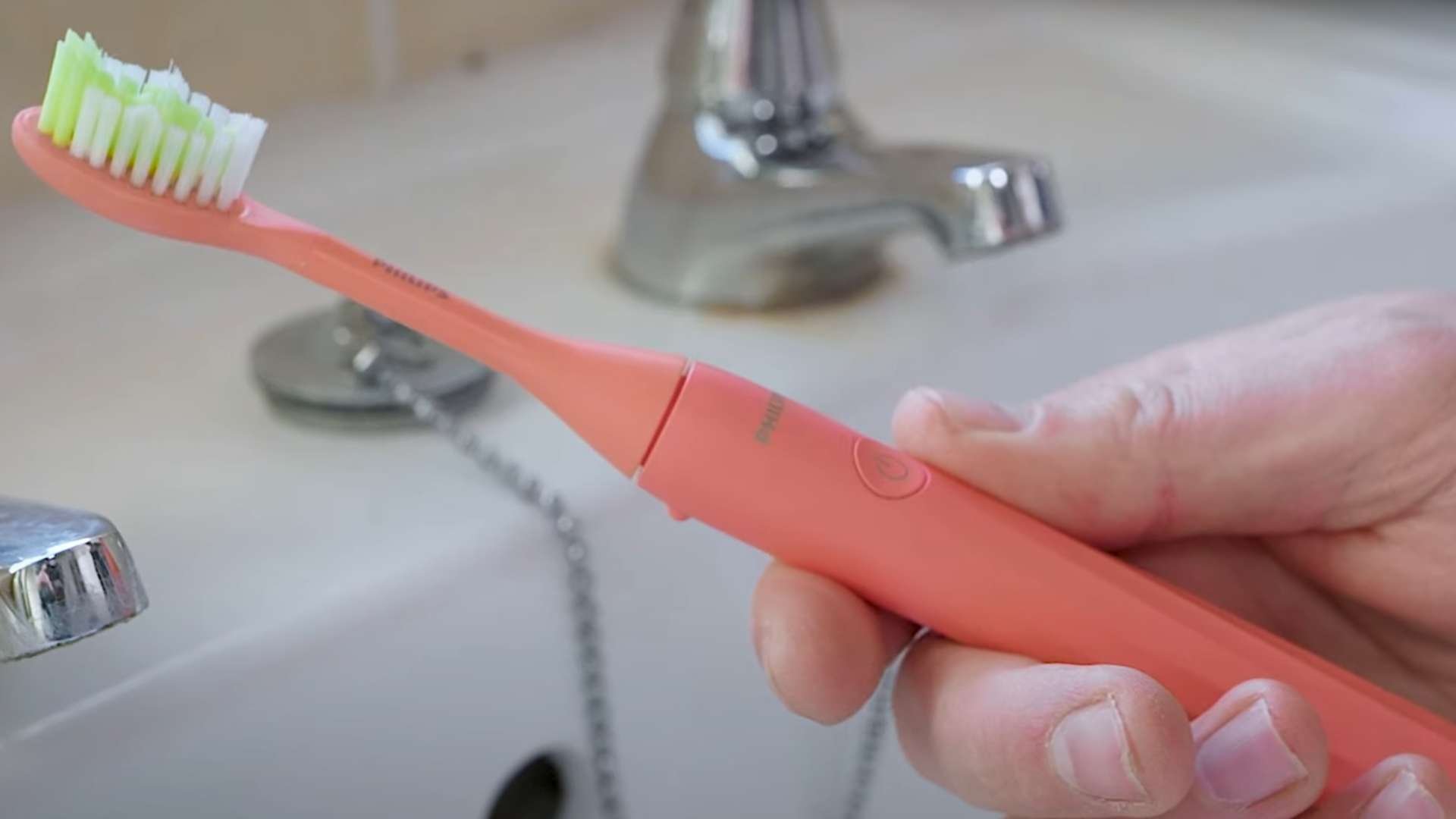
The best battery toothbrush - ideal for those traveling light
The Philips One by Sonicare is a strong performing compact electric toothbrush.
Slip and grippy, the stylish brush comes with a practical travel case.
A great step up from a manual toothbrush, it will help you clean your teeth better. But, it doesn’t quite offer the same cleaning power as a typical electric toothbrush.


Pros |
Cons |
|---|---|

Slim, light and grippy in hand |
The cleaning power is a little weak |

Various color choices |
The battery cover is potentially prone to damage (Philips One Battery) |

A travel case is included |
No battery charge feedback (Philips One Battery) |

Choose between a removable/rechargeable battery option |
No pressure sensor to alert you when brushing too hard |

The rechargeable variant has a USB-C connector |
|

Option to buy with a subscription plan |
Consider these other brushes
If I were buying a brush today, the Oral-B Smart 1500 would be my choice.
It’s affordable, cleans the teeth well, and has the features you need. It is our number 1 choice for the best electric toothbrush.
If you particularly want a toothbrush powered by a removable battery, then Quip is a potential alternative.
The Philips One, is the best battery toothbrush in my opinion, it feels like it cleans a bit better.

Subscriptions and cost
The Philips One has been designed and configured to be sold primarily on a subscription basis.
What Philips class the ‘One purchase + brush head subscription’ it works as follows:
- You select the variant you want. Your choice is the rechargeable or removable battery model.
- You select which color toothbrush you want.
- You then $24.99 for the removable battery option and $39.99 for the rechargeable variant.
- Your chosen toothbrush is delivered within 2-5 business days
- 3 months later you are charged $4.99 for a single replacement brush head (color matched by default, but you can choose) and AAA battery (if applicable).
- The brush head and battery are delivered within 2-5 business days
- Steps 5 and 6 repeat until you cancel the subscription.
You can update, pause. or cancel the subscription at any time.

Removable battery variant
This means, over the first year of the subscriptions you will pay $39.96 (24.99 + 4.99 + 4.99 + 4.99) and the years after you will pay $29.98 (4.99 every 3 months).
Philips does still make it easy to purchase without a subscription, if you would prefer.
You can purchase the One, for $24.99.
It will then be down to you to order replacement brush heads and a replacement battery when you need them.
Replacement brush heads are available in packs of 2 for $9.99, but Sonicare does not sell the AAA battery on its own.
The benefit of the subscription is that not only do you get a brush head delivered when you should theoretically need it, but you also get a free AAA battery included (if applicable).
Rechargeable battery variant
This means, over the first year of the subscriptions you will pay $54.96 (39.99 + 4.99 + 4.99 + 4.99) and the years after you will pay $29.98 (4.99 every 3 months).
Philips does still make it easy to purchase without a subscription, if you would prefer.
You can purchase the One rechargeable, for $39.99. That is $15 more than the AAA battery powered version.
It will then be down to you to order replacement brush heads when you need them.
A pack of 2 retails for $9.99.
You can also take advantage of the ‘Brush head subscription’. This is designed for those that may have already bought the Philips One, but didn’t subscribe at the time of purchase. Or it for those who require extra brush heads at set intervals.
The price is $5.00 and each delivery will include a single head (color of your choosing) and a AAA battery (if applicable), dispatched at 3 monthly intervals.
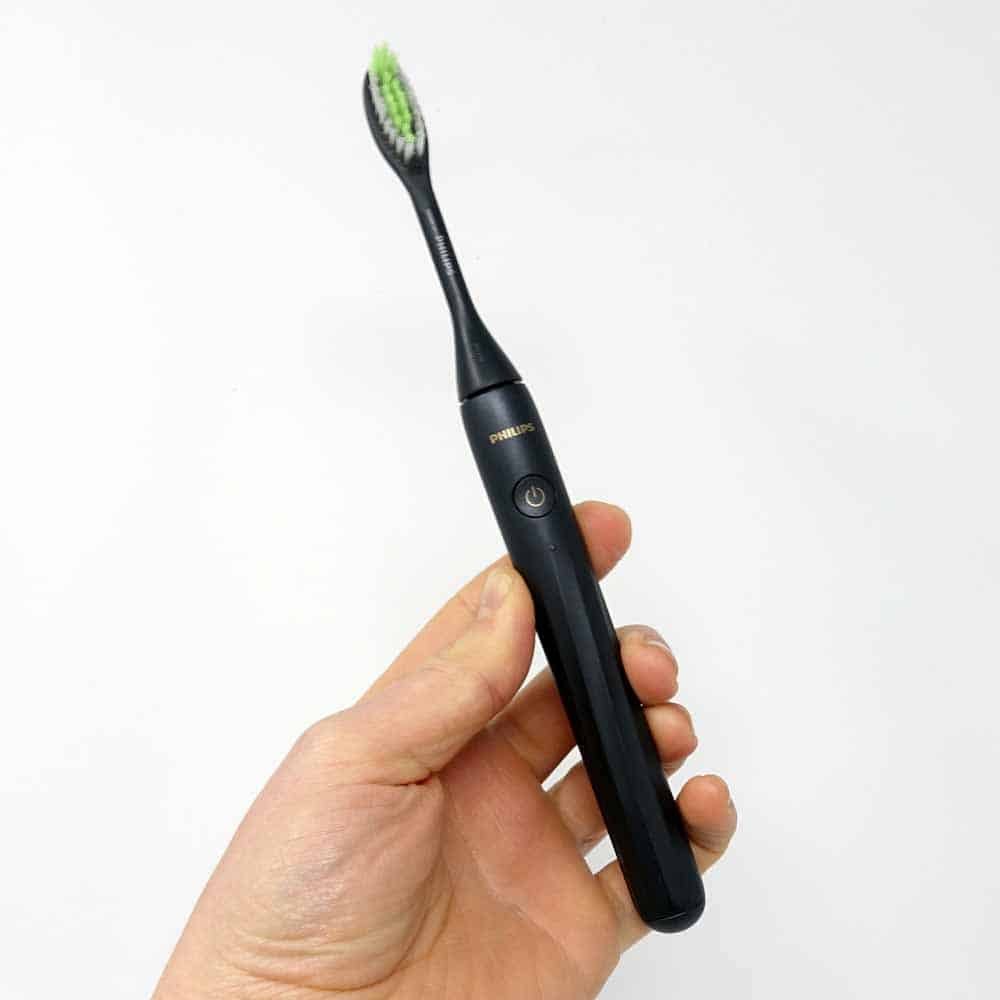
Design, usability, clean & general use
Simply packaged, the Philips One comes with what you need and not lots of extras, which isn’t all that surprising for the price.
Out of the box, you get the toothbrush handle, a head, the travel case, and a AAA battery which is pre-installed in the brush handle.
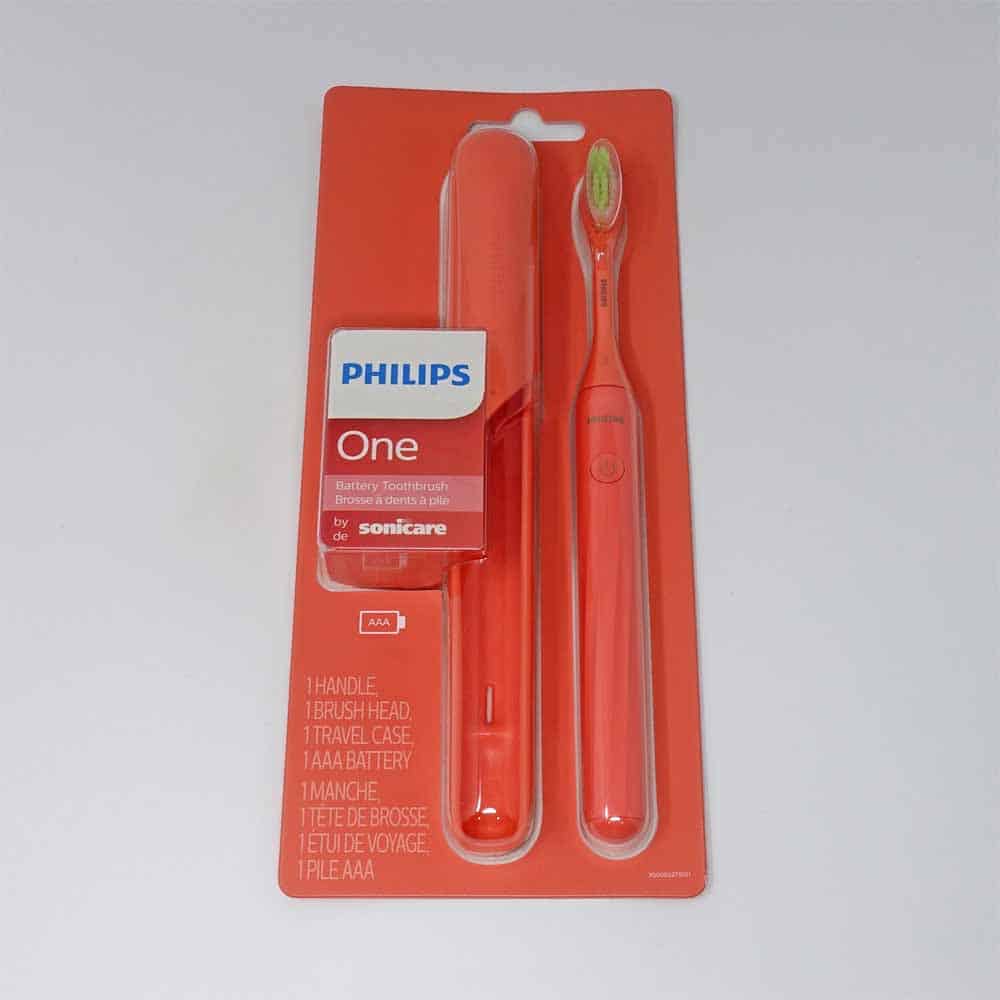
If you opt for the rechargeable variant, you will get a USB-A to USB-C cable included in the box instead of the AAA battery.
In my opinion, Philips Sonicare have always done a pretty good job when it comes to the design of their toothbrushes and this is by no means an exception.
In truth, I wasn’t quite sure what to expect. Yes, I hoped for something that felt good in the hand, but I have been pleasantly surprised.
The handle itself is slim and grippy. At approximately 0.7 inches (1.7cm) wide, it is somewhere between a writing pen and a marker pen in thickness, marginally thicker in the hand than a sharpie.
It feels grippy thanks to the contoured grooves in the handle.
The images depict these best, essentially rather than being ridges that run straight down the handle, they sweep across the handle at a shallow angle to create not only an interesting look but the important in-hand grip.
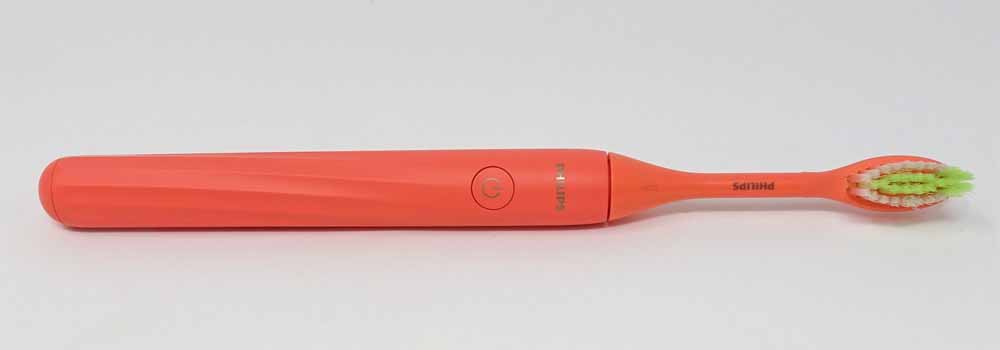
The way it has been done is very subtle but very effective.
The Philips One is made of plastics and is not a metal handle as is common with the likes of Quip.
The textured grip runs all around and virtually the full length of the handle. It is approximately the top quarter of the handle that is smooth to the touch and free of additional grips.
It is on the front of the handle where the single power button is placed. Quite a small button with a concave design, it provides a satisfactory level of feedback.
Above the power button is the Philips (not Sonicare) brand label.
The whole handle is rounded as is the removable battery cap on the bottom of the handle. As a consequence, this toothbrush does not stand upright.

You have to lay the toothbrush flat on a countertop, but thanks to 2 small plastic notches on the back of the handle, just below the brush head, this does not easily roll around.
On both variants, the cap on the bottom of the handle is rounded.
The Philips One Battery cap can be removed by inserting a coin or screwdriver into the depression within it. Unscrew it to access the AAA battery inside.
A small printed icon on the handle shows which way to insert the battery. There are also 2 dots on the handle that align with a dot on the removable cap to clearly show when the cap is and is not locked in place.
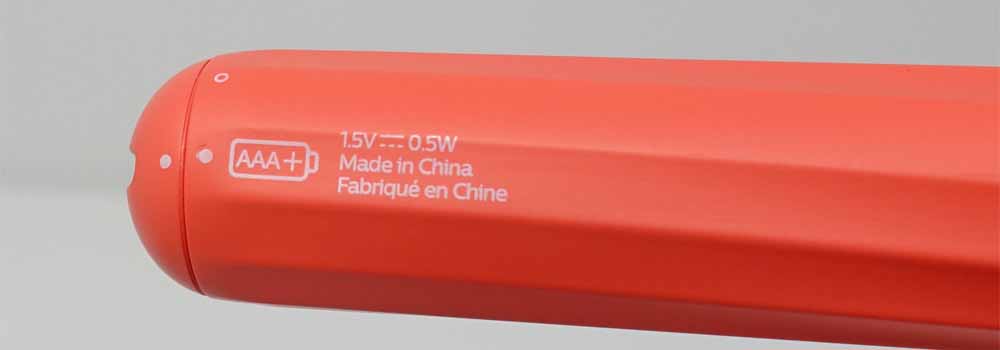
The removable end cap does what it needs to do. I do find those that require a coin or a screwdriver a bit more awkward than a pull style cap. They can be more secure, but I have found that the plastics on the cap can be prone to a bit of damage as the coin or screwdriver twists within the slot. I had the same issue with the Gleem battery operated toothbrush.
It is not a massive issue, just a small observation. Over many years I would be interested to know how it fares. Thankfully you need only open the cap approximately once every 3 months.
This frustration is overcome with the rechargeable variant. You pull the cap out from the base of the handle using a fingernail. It comes loose, revealing the USB-C charging port. But, the cover remains connected to the handle thanks to rubber connector.
The Philips One Battery handle I have is what I would describe as a coral/pink color, but Philips calls this ‘Miami’.
There are 4 different color options with the battery variant. Your choices and their part numbers are:
- Miami (Coral Pink) - HY1100/01
- Mango (Yellow) - HY1100/02
- Mint - HY1100/03
- Midnight (Dark Blue) - HY1100/04
The rechargeable version comes in 3 colors. They are:
- Shimmer - HY1200/05
- Shadow - HY1200/06
- Snow - HY1200/07
It is the shadow option that I have. It is essentially black. Shadow is a bit of a fancy name.
Now, extending from the top of the handle is the metal shaft onto which the supplied brush head fits.
It is straightforward to fit, simply push it on and pull it off.
This brush head is specific to the Philips One.
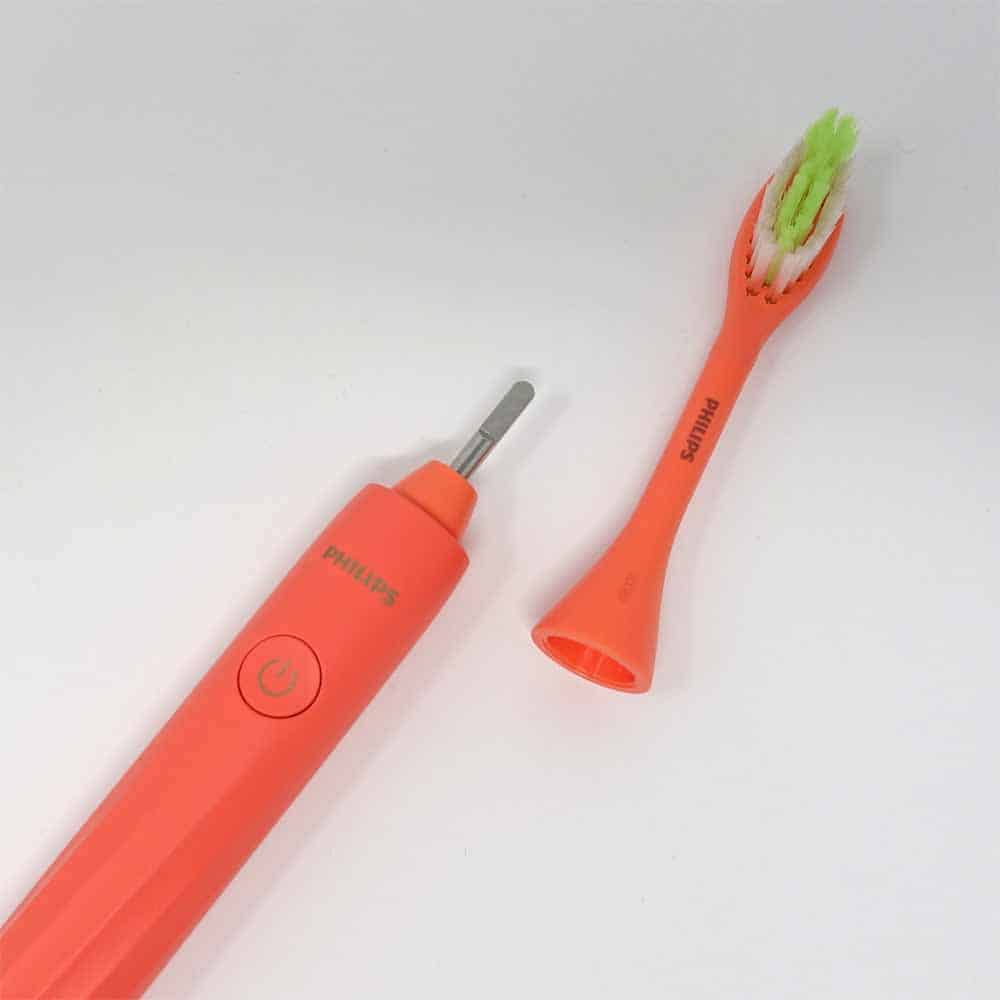
Standard Sonicare electric toothbrush heads do not fit this brush handle and the Philips One brush head does not fit to Sonicare electric toothbrushes.
There is just 1 style of brush head for the Philips One, not numerous different styles like you get with Sonicare toothbrushes.
The brush head is color matched to the handle, which is a nice touch.
They are sold in packs of 2, although if you subscribe, you get an individual head delivered every 3 months.
The brush heads and their part codes are as follows:
- Miami - BH1022/01
- Mango - BH1022/02
- Mint - BH1022/03
- Midnight - BH1022/04
- Shimmer - BH1022/05
- Shadow - BH1022/06
- Snow - BH1022/07
Although you are likely going to use the head matched to your handle color, you don't have to. They are interchangeable.
The head itself is similarly sized to the brush heads you would find on a typical Sonicare electric toothbrush.
From a side profile, you can see that it has a W profile to it, with slightly longer bristles at each end of the head and in the middle.
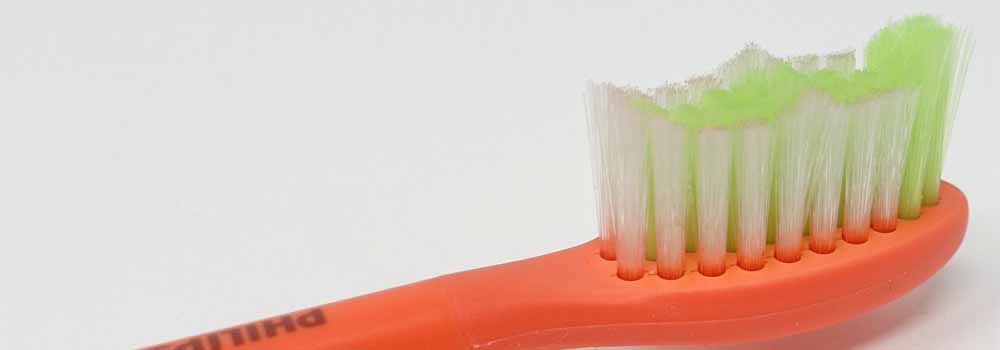
Philips do not specifically state that these are soft bristles, but they certainly felt fairly soft. A bit firmer than the softest brush heads I have used, but much more gentle on the teeth and gums than some of the firmer bristled heads I have used.
The brush has just 1 cleaning mode, which is activated by a single press of the power button.
The clean mode lasts for 2 minutes in total with the brush automatically turning itself off at the end of the 2 minute cleaning cycle.
During the 2 minutes it is active, at 30 second intervals there is a brief pause in the brush head motion, which in turn causes a change in the brushing sensation and sound. This is the 30 second pacer.
The principle here is that you spend 2 minutes brushing your teeth, but it is important to clean all the teeth evenly. To do this you break the mouth up into 4 sections (upper right, upper left, lower right, lower left), known as quadrants, and you spend 30 seconds cleaning each. If you do this, twice a day, you should be well on your way to a healthy smile.
To me, the timer and pacer are really important features. Too many of us fail to brush for the right amount of time, so these help encourage you to brush for longer. Simply put, if the toothbrush hasn’t turned itself off, you need to keep brushing the teeth.
You can’t change the brushing time and there is no pressure sensor built into this brush.
A pressure sensor will alert you when you are brushing with too much force. Scrubbing with lots of pressure does not produce a better clean. The bristles just need to be lightly pressed against the teeth and gum surface.
When in use, the brush produces a quiet audible humming sound and a vibration sensation through the handle. It is comparable to most other sonic toothbrushes in terms of the sound and vibration produced.
The actual cleaning power and performance of this toothbrush is satisfactory, particularly when you consider how slim the handle is.
I was certainly very pleased with the overall cleaning results after each use. My teeth and gums felt clean, but it does not deliver the cleaning power of a conventional electric toothbrush.
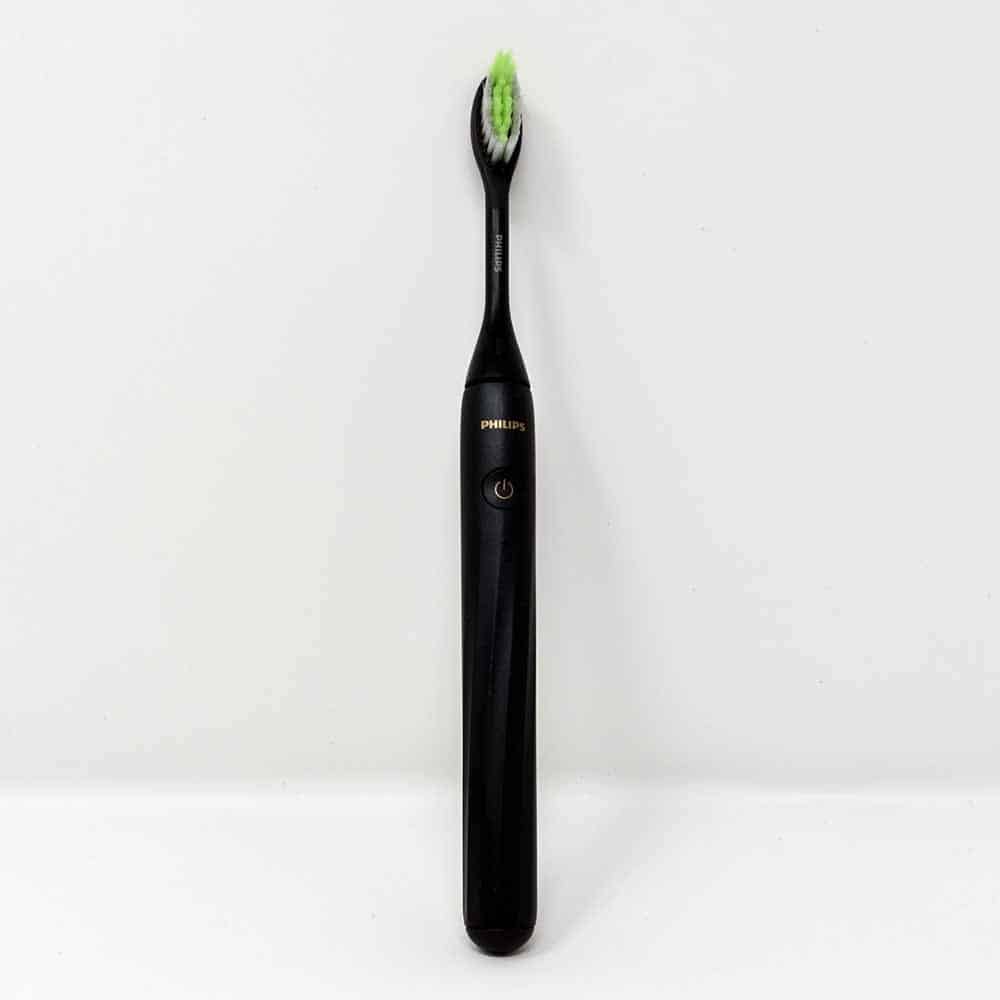
To me, this is a crossover between manual and larger electric toothbrushes.
You get the benefit of significantly more movements in the brush head compared to a manual, but there isn’t the same power and intensity you get with a Sonicare toothbrush with a built-in rechargeable battery.
You feel it is necessary to move the brush at the same time the motor is running to get the maximum effect.
This isn’t a situation that is unique to the One by Sonicare. I feel the same with Quip and Gleem.
I would say that this Philips One feels the most powerful of all 3.
A Sonicare toothbrush, like the ProtectiveClean 4100, offers 31,000 brush strokes (62,000) movements per minute.
The Philips One is not as powerful as this.
Sonicare’s website nor the official packaging makes any mention of how powerful the motor inside the brush handle is.
I spoke with the customer service representative on live chat who advised me that the brush produces 31,000 brush strokes per minute.
I disagree with this.
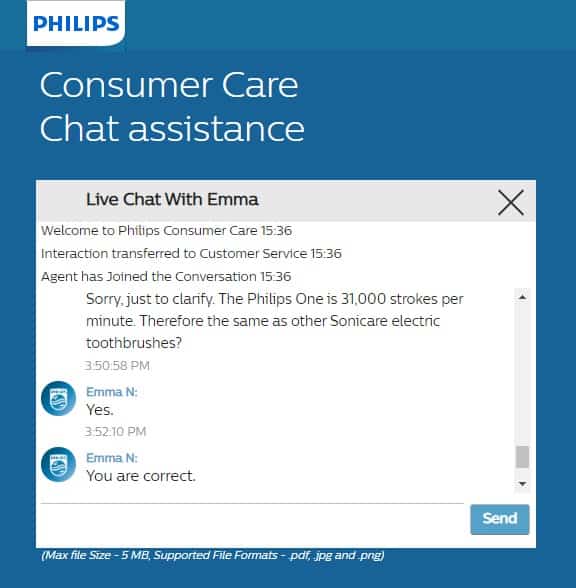
I have no hard evidence to confirm that the strokes or movements per minute are less, but in actual use, I could tell the difference.
The brushing sensation is different. The motor in the Philips One is less intense when it cleans.
I felt like I needed to move the toothbrush the same way I would a manual one.
I suspect the motor is offering something like 15,000 strokes per minute. This would be equivalent to 30,000 movements. That is half the power and number of strokes/movements of the 4100.
If the Philips One is truly supposed to offer 31,000 strokes per minute, the unit I have is faulty. I don’t think it is though.
If it is possible to get such power from a motor so small, which are most other electric toothbrushes so much larger?
Update: Sonicare have since confirmed the Philips One offers 13,000 brush strokes per minute.
I could happily use this on a daily basis, but having used more powerful electric toothbrushes I notice the difference.
To me, the One is a crossover from manual and electric, a best of both if you like. More cleaning power but still slim, lightweight and easy to use.
The data suggest that in reality, the extra cleaning power won’t make a significant difference in how clean the teeth are, providing you are using the correct brushing technique.
That said, I suspect like me, existing electric toothbrush users would be underwhelmed and prefer the more powerful options. Even if partly psychological, the clean feels better.
Whilst Philips do not advise bathing with the One, it should survive a rinse under the tap. It will resist splashes, toothpaste and saliva. It is not waterproof though.
The last thing to talk about is the travel case that comes provided with the Philips One.
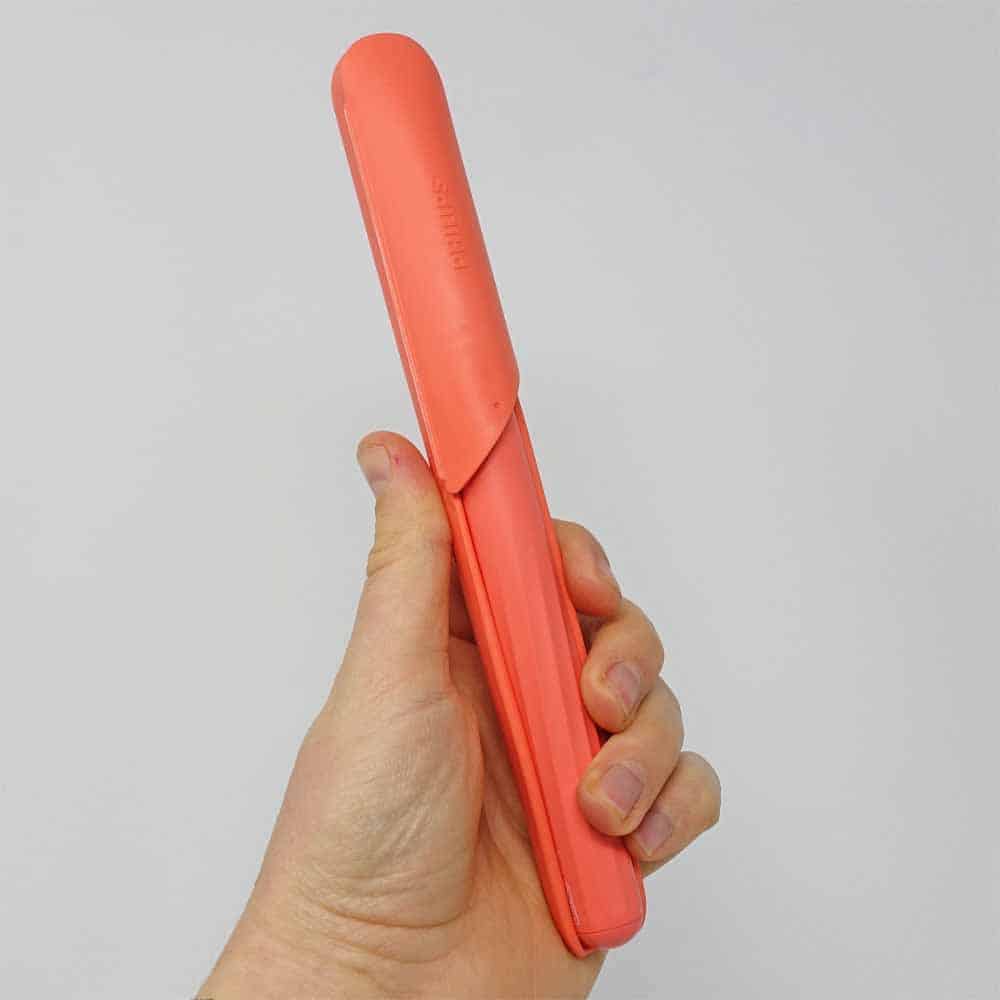
Color matched to the handle, it is a slim and well thought out case, I like it a lot.
Describing the case is quite tricky, the hands-on images are best looked at to really understand it.
Essentially what you have is a cylindrical tube. Now imagine that tube has been cut open lengthways and hinged on one side, opening up a bit like a book cover might.
This hinging gives you 2 parts, the bottom and the top of the case.
The bottom of the case, on the outside surface, has been flattened out, so that it does not roll about. Instead, it sits still on a countertop.
On this flatter, bottom edge are some contours that help provide the grippy surface to stop it moving. 2 slits in the case here also allow airflow to the toothbrush that sits inside.
The toothbrush itself lays on the inside of this bottom half of the case, with the bristles pointing into the case.There is a ridge on which the toothbrush head aligns within the case that allows the brush to sit securely inside.
The top cover then closes over the handle. But, this cover only stretches a third of the way down the handle, covering just the brush head. This leaves a part of the toothbrush handle (not the head) exposed.
The smaller cover adds a unique style to the case, but also does away with unnecessary bulk. The reality is that once inside, the head is protected under the cover and the part of the handle that is exposed is very unlikely to become damaged.
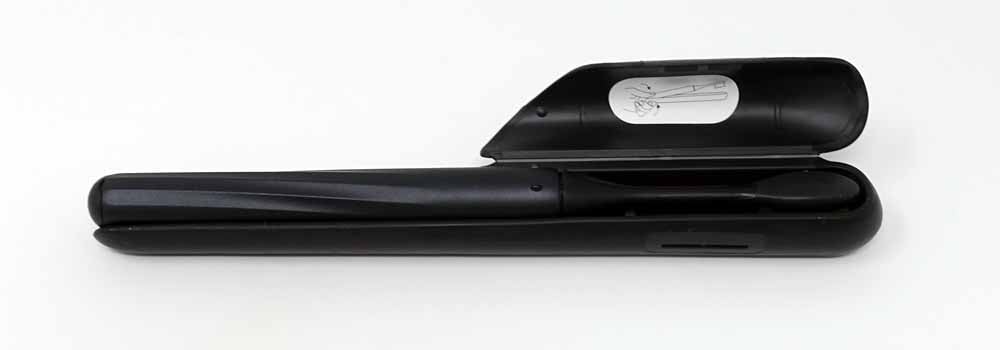
There is a slightly tapered design to the case. It is wider at the top than the bottom.
A Philips logo is embossed on the lid.
I am not sure of the exact material, but the case has a grippy soft touch to it. It essentially has a rubber coating/finish to the case which is really nice.
The whole design works well to not only protect the handle, but allow airflow to access the head to dry it out and keep the overall weight and size down.
Philips have always done a pretty good job with their electric toothbrushes and this is really no exception.
In fact, in many respects I am more impressed with this than I am with some of the top of the line products, the simplicity is great.
I could use this as my daily toothbrush. But, in truth, I prefer the power of Sonicares other electric brushes.
The size and portability are definitely the biggest draw.
The Philips One by Sonicare is a great product.
If you want a compact, travel friendly electric toothbrush, then this has to be the one to go for.
Summary of design, usability, clean & general use
Battery life
The Philips One is powered by a single AAA battery or a rechargeable Nickel Metal Hydride battery. It depends on the version your pick.
Starting with the Philips One Battery. You get 1 battery included in the toothbrush when you purchase it.
It is not a rechargeable battery, although there is no reason why you could not use a rechargeable AAA in it.
If you subscribe to Philips One, a replacement battery is provided every 3 months, along with the replacement brush head.
Sonicare suggests that the battery should last about 90 days. This is based on the toothbrush being used twice a day for 2 minutes each time.
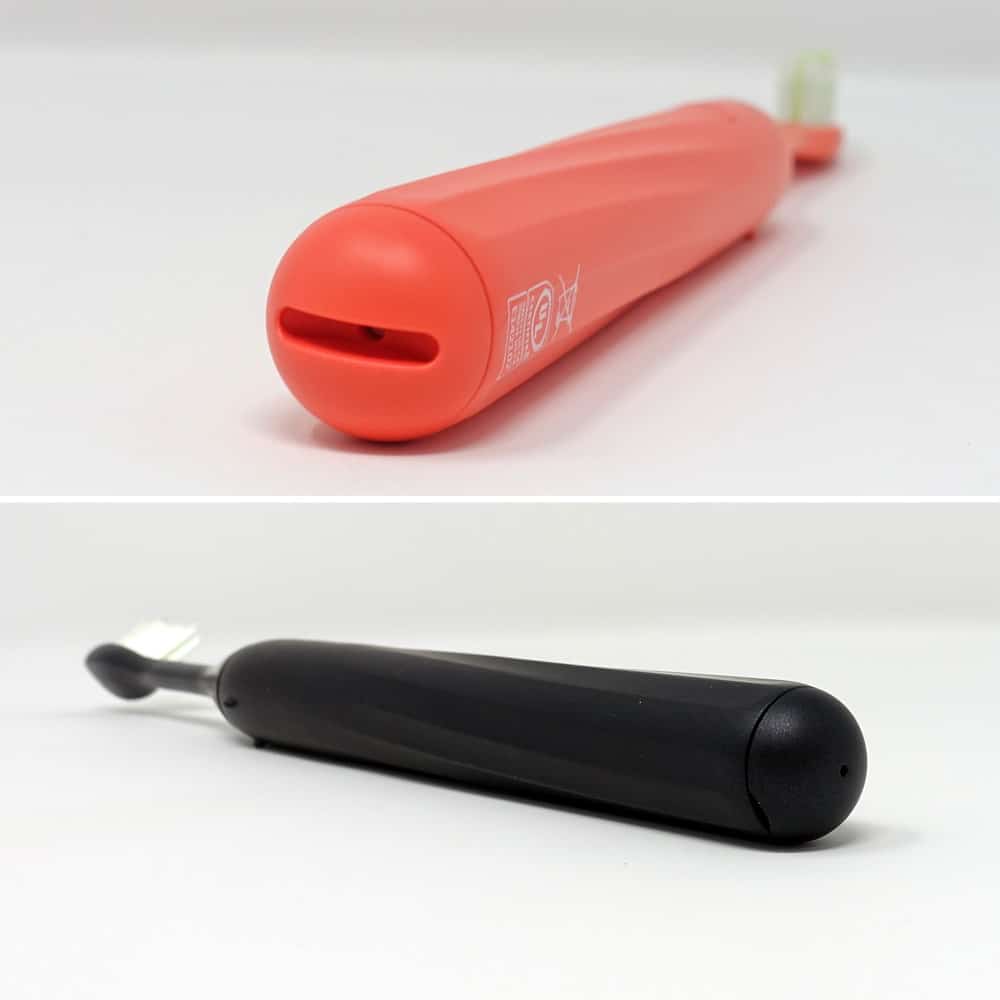
My own hands-on testing has shown that the battery will actually last a little longer. Even after 140 days or 280 brushing sessions, the brush was still going. That is over 4 months from a single AAA battery.
By 150 days (5 months), the brush movements had decreased significantly and the battery was very close to running out. You would want to replace the battery by now.
Whilst you probably want to drain the battery as much as possible before replacing it, there is a logic to replace the battery every time you replace the brush head.
With the Philips One Battery, there is no indication of how much power remains in the battery. There is no charge/status indicator for the remaining power.
The reality is the brush will gradually get slower and you will notice that the brushing sensation is not as intense. Eventually, it will stop.
It ultimately seems a shame to dispose of a battery that has some working life left in it, given that on average it is lasting 50 days longer than Sonicare suggests, but having a refreshed battery every 3 months keeps things nice and simple.
The performance in terms of battery life is comparable to other products of this type and there is a certain convenience to having the power source be an easily sourced AAA battery.
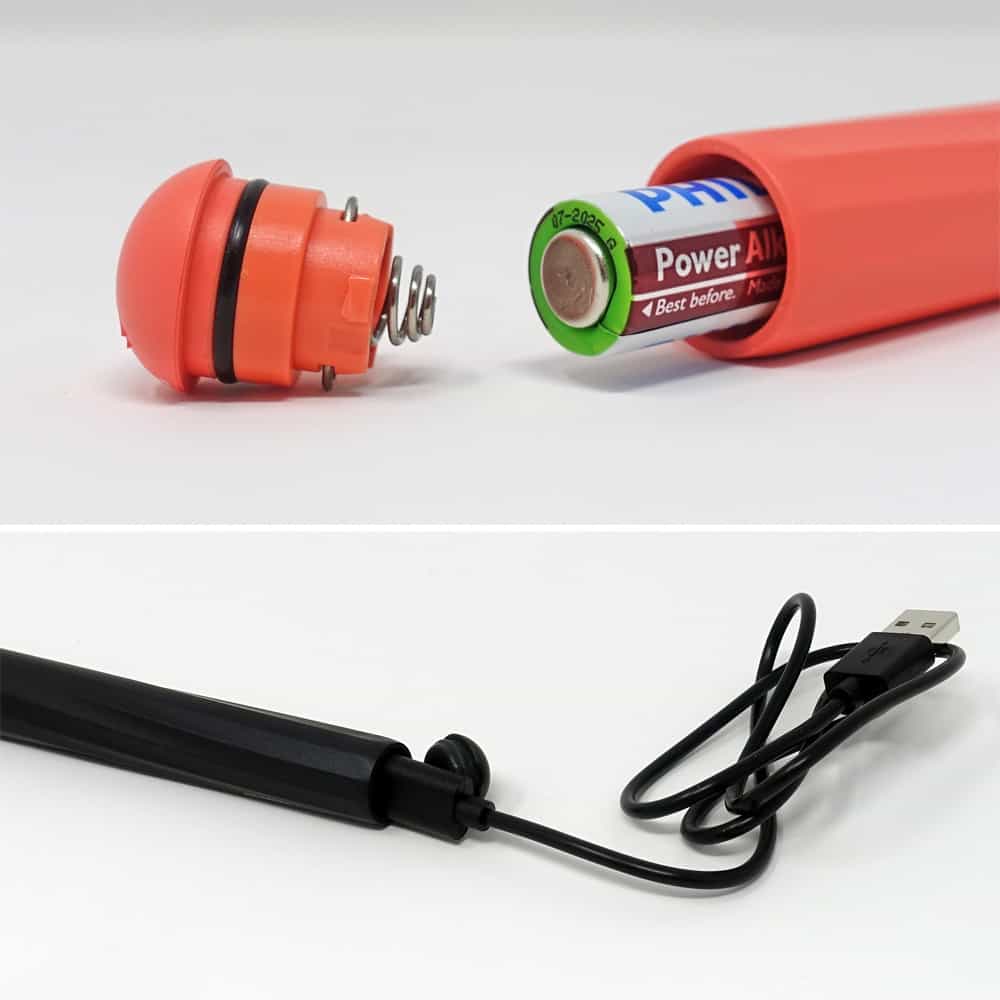
With the Philips One Rechargeable on the other hand, you get feedback on the remaining battery power.
The NiMH battery is designed to last up to 60 brushing sessions. This is equivalent to 30 days, based on 2 brushing sessions a day, each 2 minutes in length.
My own hands-on testing has shown that the battery will actually last quite a bit longer. I achieved around 86 brushing sessions. That is 43 days on a single charge. That is 13 days longer than Sonicare quotes.
A small battery status indicator is located just below the power button.
This is how it behaves:
- Solid white light - 40-60 brushing sessions remain
- Fading up and down white light - 7-39 brush sessions remain
- Amber flashing light - Less than 6 brushing sessions
- 5 beeps after the brushing session
- Aber flashing light and 5 bleeps twice - 0 brushing sessions remain
Just be aware that the battery life appears to be better than Sonicare claim. So in each instance, the brush will last for longer than the stated sessions.
A full charge of the battery can take up to 8 hours.
When the power cable is plugged in, you will get beeps twice to indicate it is charging.
When the Philips One Rechargeable is on charge the battery indicator light fades up and down with a white light.
Once fully charged the light turns a solid white and turns off after 30 seconds.
You need to use the supplied USB-C cable to recharge the brush.
At one end is a USB-C connector that can be inserted into the charging port inside the handle. You need to pull open the cover on the base of the brush handle to reveal this. One the other end is a male USB Type A connector. This needs to be connected to a USB socket on computer or plug adapter.
A plug adapter is not provided. You should use only a 5V USB wall adapter.
Summary of battery life
Price & where to buy
I have included links to buying options here at the start of the review.
In the section below, I discuss the price more generally and in relation to similar products.
As you will have likely understood by now, the Philips One has been primarily designed to be a subscription based toothbrush service.
Some might wonder why you need a subscription for a toothbrush, but data shows us that only 4 in 10 replace their brush head at the recommended 3 monthly intervals.
No toothbrush subscription can actually make the physical switch of the brush head for you, but they can certainly help prompt you by delivering a replacement head just when you need it.
The idea here is that you set up the subscription and forget about it and then at the 3 monthly intervals a replacement head and battery are delivered to your door.
The task of buying replacement brush heads is taken away because the subscription manages this for you.
You do not have to subscribe, you can purchase the toothbrush and heads as and when you would like if you prefer.
At the time of writing the price of the Philips One Battery toothbrush, whether you buy on subscription or not is $24.99.
The Philips One Rechargeable is $39.99.
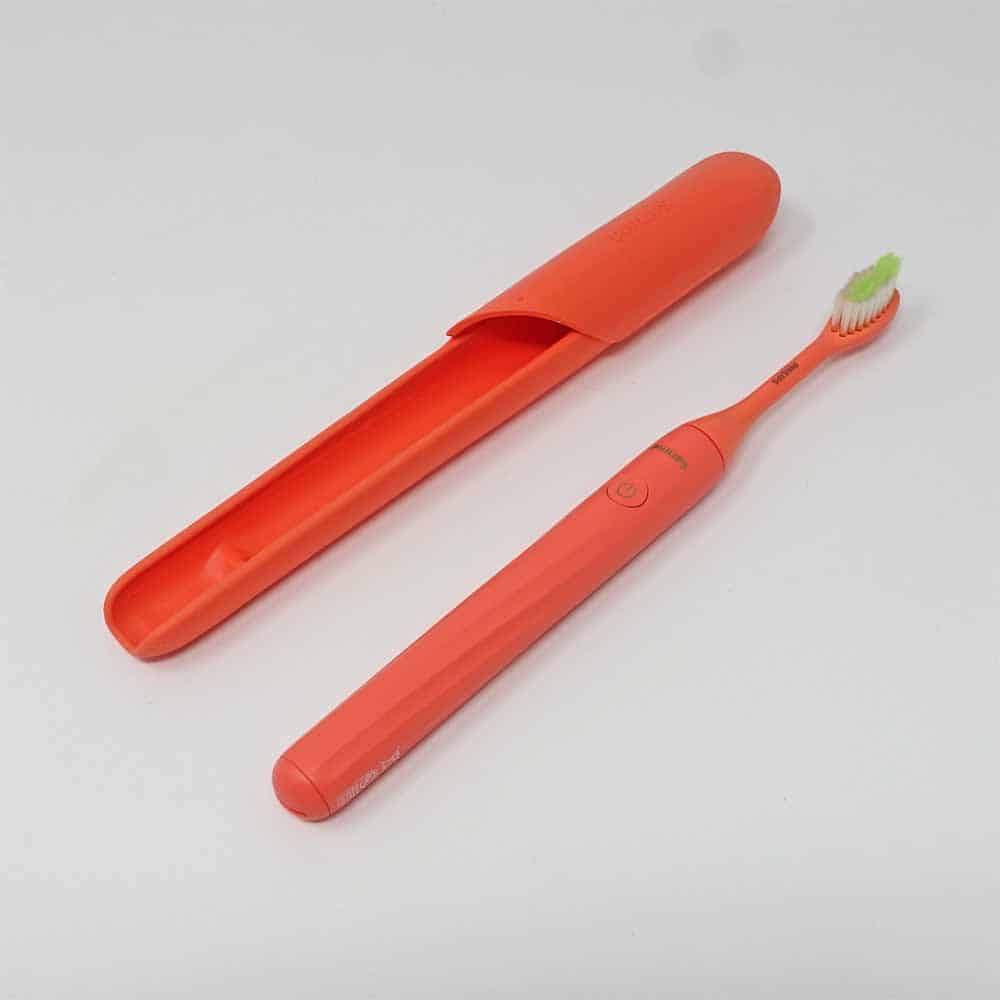
Phillips is selling both variants, on and off subscription themselves.
You can buy both models and the replacement heads from other retailers. However, you cannot purchase a subscription from other stockists.
If you subscribe, at 3 monthly intervals, you will be charged $4.99 and a brush head along with a AAA battery (if applicable) will be dispatched to you.
This continues every 3 months until you change or cancel the subscription.
You can update, pause or cancel whenever you wish.
There are no delivery charges or hidden fees with the subscription.
If you are not subscribed, you cannot purchase a single brush head. You have to buy them in packs of 2, at $9.99.
You would too need to purchase AAA batteries (if applicable) if you are not subscribed.
Even if you have not purchased the brush on a subscription plan, you can subscribe to the brush heads only at a later time if you would like.
Sometimes you can pay a premium for the convenience that is offered with a subscription, but this is not the case with Philips. In fact, you get a AAA battery free of charge/included where you don’t when you buy without a subscription.
Personally, I have not subscribed so I can’t comment on how well this works, but I have no reason to doubt it.
Typically here at Electric Teeth we like to work out the cost of ownership of a toothbrush over 3 years, to give an idea of the cost and act as a benchmark for comparison to others.
Because the One can be purchased on and off subscription the cost will be slightly different. The following prices are based on subscribing.
For the Philips One Battery. In year 1, you have a total cost of $39.96 and then a cost of $19.96 in year 2 and 3.
This brings the total cost to $79.88 or $0.07 per day.
For the Philips One Rechargeable. In year 1, you have a total cost of $54.96 and then a cost of $19.96 in year 2 and 3.
This brings the total cost to $94.88 or $0.09 per day.
Quip is one of the possible products you may consider as an alternative to the Philips One. Quip works out at $0.09 per day.
Quip uses a removable AAA battery like the Philips One Battery. Therefore the Philips One Battery option is cheaper by $0.02 per day or $22 over 3 years.
The Philips One Rechargeable is the same price as Quip.
For the sake of comparison, the ProtectiveClean 4100, which is one of the most popular Sonicare electric toothbrushes, works out at $0.13 per day. It is nearly twice the price, but it does offer some notable benefits.
Please note that all prices quoted are approximates and will vary based on location, supplier and time of purchase. These figures were correct at the time of writing and should not be relied upon as hard fact, but used as a guide during your decision process.
Summary of price & where to buy
Reliability & long term use
This is a completely new type of electric toothbrush from Philips.
It does not share the same design and features of any other model, so there isn’t the track history that you might have with some other toothbrushes.
I tested this toothbrush for a few weeks to be able to write this review and found no significant cause for concern surrounding the reliability of the product.
Being an electric toothbrush it will be exposed to water and is more prone to going wrong. That said the construction is good and I have no immediate concerns.
Battery compartments can be a weakness, for letting water seep in. The design is such that it is unlikely here.
My biggest concern, if I can call it that, is the durability of the cap on the bottom. This applies more to the Philips One Battery. I fear the thread could wear if you are not careful. All being well it will be fine.
Both variants come with a 1 year warranty, so if things should go wrong, you are covered. It is a shame it is not a 2 year warranty like most electric toothbrushes.
Conclusion
The Philips One is a great toothbrush.
The size, weight and portability are what make it so appealing.
I really like the travel case and the simple subscription plan adds a convenience that you don’t get with most traditional electric toothbrushes.
Ultimately I still prefer the more powerful brushes over the Philips One. The more intense cleaning action gives a greater level of satisfaction.
Existing electric toothbrush owners will be a bit disappointed and if you are considering this as your first electric brush, I advise you consider the likes of the Oral-B Smart 1500.
If you want a product that is a crossover between manual and electric, then this is a fantastic option.
And of the 2 variants, my pick is the rechargeable.
Size guide
- Toothbrush height with head - 20.3cm / 8 inches
- Toothbrush height without head - 15cm / 5.9 inches
- Width - 1.8cm / 0.7 inches
- Depth/thickness - 1.8cm / 0.7 inches
- Weight with head - 39g / 1.4oz
- Weight without head - 34g / 1.1oz
- Travel case size - 21cm / 8.3 inches (L) x 6.2cm / 2.4 inches (W) x 3.4cm / 1.3 inches (D)
- Travel case weight - 30g / 1.1oz without brush or 69g / 2.4oz with brush
- Package weight - 99g / 3.5oz
Noise
- 71dB
Country of manufacture
- China
Philips One Battery vs Rechargeable
There are 2 main variants of the Philips One by Sonicare.
- Philips One Battery
- Philips One Rechargeable
As the name implies, one is powered by a removable AAA battery whilst the other has a rechargeable battery built-in.
Both variants offer the same cleaning performance. The difference is their power source.
The battery version should last 90 days with a new battery. The rechargeable will last 1 month (60 brushing session) on a single charge.
The rechargeable variant does have a battery status indicator light below the power button.
Each variant is then available in a number of different color options.
The choices and their official part codes are:
- Philips One Battery
- Miami (Coral Pink) - HY1100/01
- Mango (Yellow) - HY1100/02
- Mint - HY1100/03
- Midnight (Dark Blue) - HY1100/04
- Philips One Rechargeable
- Shimmer - HY1200/05
- Shadow - HY1200/06
- Snow - HY1200/07
Each variant has a color matched brush head and travel case.
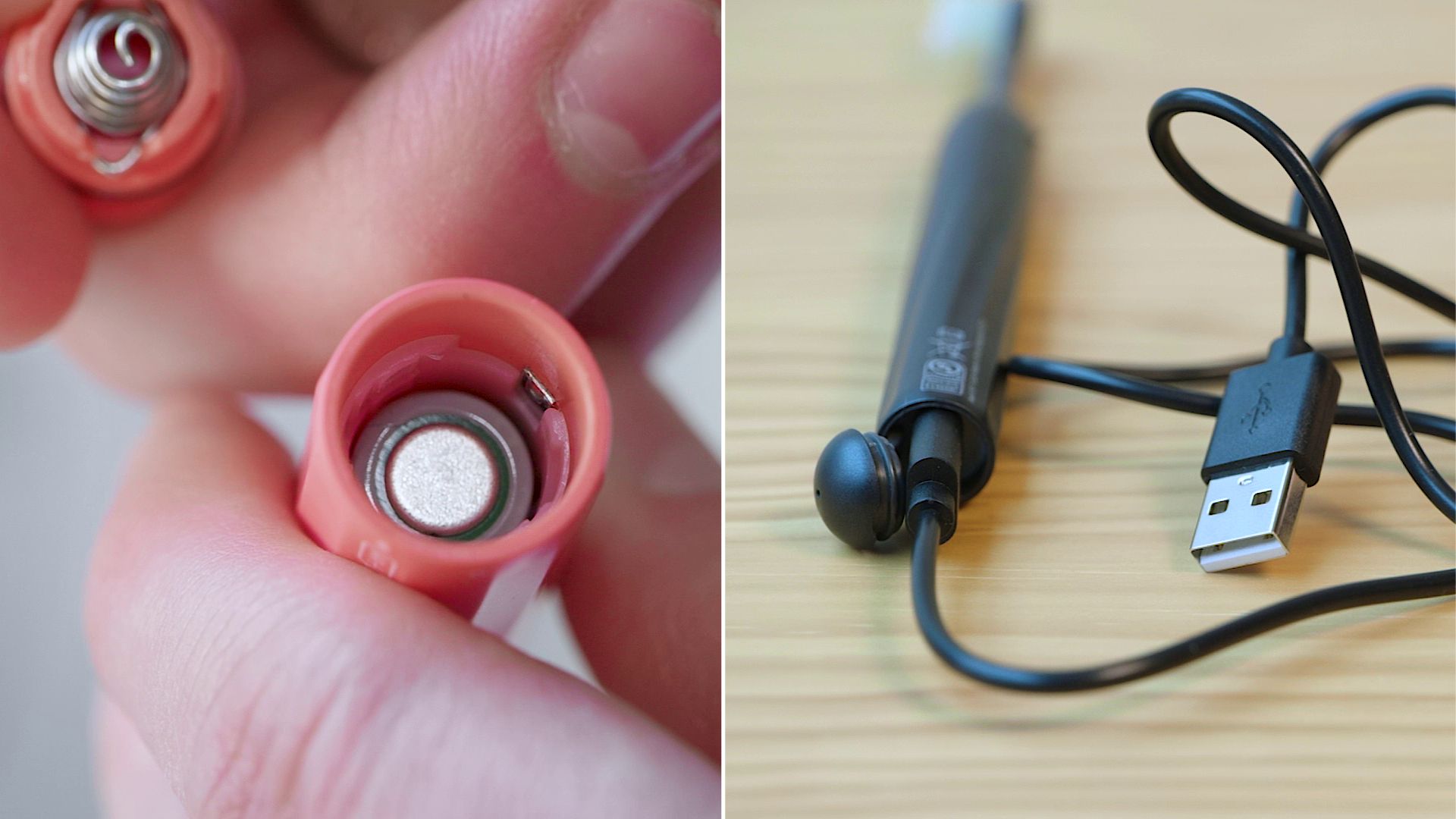
Philips One by Sonicare vs Quip
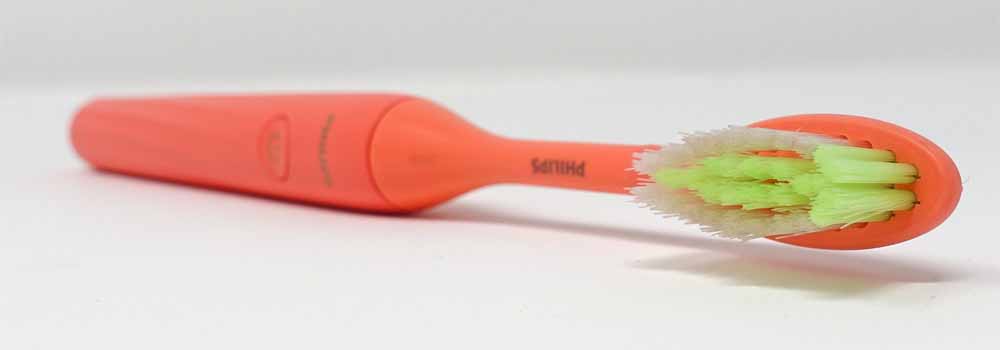
Which one would we choose?
Our choice: Philips Sonicare One – Battery / Amazon, Philips / ~$24.96
2nd choice: Quip Adult Electric Toothbrush – Battery / Amazon, Quip / ~$19.97
Due to the fact they are so similar, it is very difficult to say one is better than the other.
Philips is a more reputable brand. Add to this the availability of the handles and head and it becomes a slightly more attractive option.
But, there is no denying Quip is more travel friendly due to the practical implementation of the travel case come wall mount. It is also easier to replace the battery.
As I have highlighted in the review above, it is quite clear that the Philips One is the company's answer to Quip's toothbrush.
There are certainly more similarities than there are differences.
Listed below are the key differences between the 2 brushes.
Please be aware that both Philips and Quip have a couple of different versions of their toothbrushes.
Quip offers a standard and smart model, the latter offering a smartphone application for tracking key brushing data.
Philips offers a AAA battery and rechargeable version of their brush.
This comparison focuses on the removable AAA battery variant of Philips One, which is most similar to the standard (non-smart) version of the Quip toothbrush.
Both brushes are too available with and without a subscription. I am not comparing this, focusing on the actual toothbrush itself.
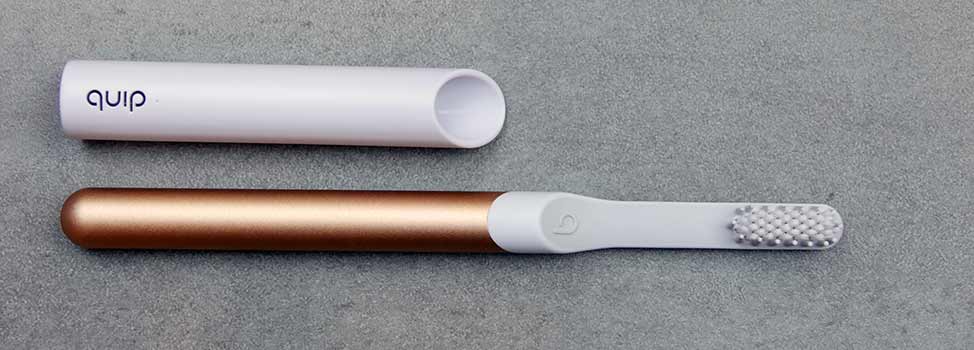
- Cleaning/brushing action
- Quip offers 15,000 movements per minute compared to 13,000 of the Philips One.
- This difference is difficult to notice and the cleaning action is equivilant. The extra movements don't result in a meaningfully better clean of the teeth.
- Quip offers 15,000 movements per minute compared to 13,000 of the Philips One.
- Handle design/colors
- Quip is available in 2 different materials (plastic & metal) in 6 colors compared to the 4 colors of the Philips One.
- Philips travel case and brush head match the handle color. This doesn't apply with Quip.
- Quip
- Silver metal
- Slate metal
- Copper metal
- Gold metal
- Blue plastic
- Green plastic
- Philips One
- Miami (Coral Pink)
- Mango (Yellow)
- Mint
- Midnight
- Quip
- Philips One has a slightly more grippy and secure feeling in hand because of the textured grip that runs down the length of the handle.
- The power button of the Philips One is located in a preferable position and is easier to access.
- Brush heads
- Quips head is marginally wide with more of a rounded rectangle shape compared to the more oval shape of Philips One.
- Quip has nylon bristles as well as a number of soft rubber bristles around the edge to help massage the gums.
- Quip has a tongue cleaner on the back of the brush head.
- Battery
- Quips battery is a little easier to replace as you don't need a coin or screwdriver to access the battery compartment like you do with the Philips One.
- Travel case
- The Quip travel case doubles up as a wall mount.
- Price
- Philips One is cheaper typically to buy outright at $25 compared to the $30 of Quip.



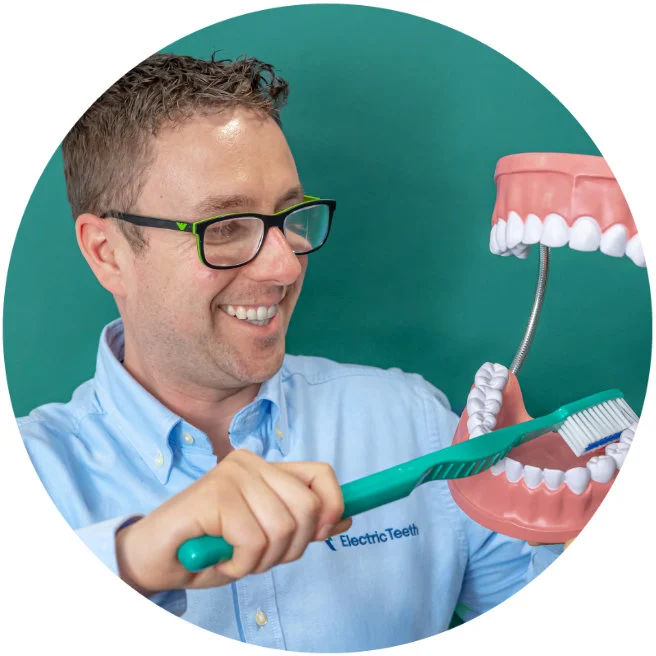
Hi Jon
Thanks for the detailed review. I’m interested in your opinion: Do you think there is an inherent limitation in this category of toothbrush that means they will always produce a disappointing experience compared to the larger, heavier electric brushes? I have used Sonicare for years, and purchased a Philips One with the goal of saving a few ounces of weight on a long backpacking trip. I know the difference may seem minimal, but it all helps when you’re carrying it for days on end. However, compared to the 4100, I found the One rather weak, and decided not to take it for that reason. I’m prone to cavities and decided it just wasn’t worth the risk. If Philips came out with a One that had similar cleaning power to the 4100, it would be a huge boon — even if the battery life was reduced somewhat.
Hi Mike.
In short, yes. I would like to see a model with the power of the 4100 in the size of the Philips One. I am sure it is technically possible but the price to achieve this is likely prohibitive for the possible market size.
Most don't need a super compact or light brush. Traveling is a great choice for those traveling light like yourself.
The Philips One used correctly can still achieve a good clean of the teeth, but the technique required to achieve this is harder.
Thought on this brush vs hum? I'm trying to move out of quip after having 2 motors fail on me and both these peak my interest. Not sure how useful the smart features are, I just like a minimal electric brush with fewer crevices so less surface area for gunk to build up which is why I'm drawn to these three. Obviously this is the more similar brush to quip, however I can keep/return the unopened hum that I got for $50 thru a sale.
Curious your thoughts.
Hi Max.
Great question. This is one I hope in the not too distant future to answer much more thoroughly in a dedicated article.
In short, it is a tricky one to answer.
From a cleaning perspective, they all feel fairly similar. I feel the Philips One is fractionally better than Quip, but the Colgate hum wins it here, it is just more powerful.
hum offers a lot for the money and I have been very impressed by it. The smart features are clever. Although not everyone will stick to daily use of such, considering the price they really are very good. In fact, I would suggest the performance is better than some of the considerably more premium options.
What you get with the Philips One that you don't get with the hum is the slightly more compact nature of the brush.
Whilst the hum is approx $25 more expensive, I think you have gotten a good deal and I would likely stick with it, even if you don't use the smart features all that often. Heck, just log in once a week, so the app syncs and you can earn $$ for brushing and ultimately get free brush heads.
I hope this helps. If you have any specific questions let me know.